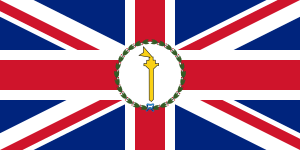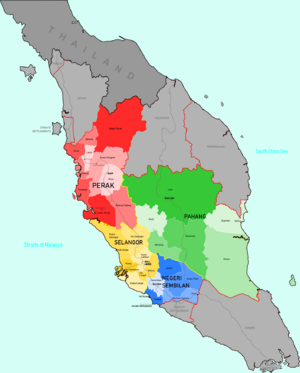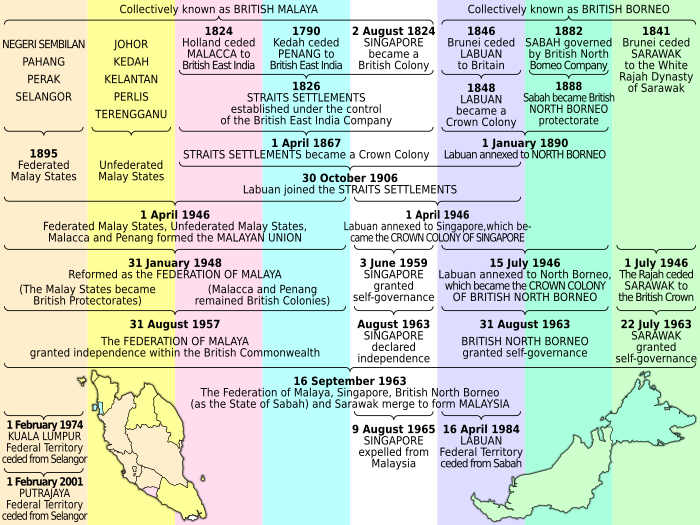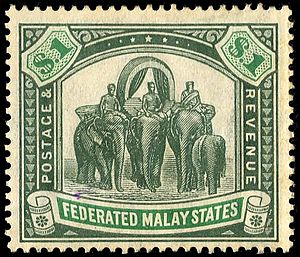Federated Malay States facts for kids
Quick facts for kids
Federated Malay States
Negeri-Negeri Melayu Bersekutu (Malay)
|
|||||||||||||||||||
|---|---|---|---|---|---|---|---|---|---|---|---|---|---|---|---|---|---|---|---|
| 1895–1941 1941–1945 (Japanese occupation) 1945–1946 |
|||||||||||||||||||
|
Motto: Dipelihara Allah
(English: "Under God's Protection") |
|||||||||||||||||||

Malaya in 1922:
Unfederated Malay States Federated Malay States Straits Settlements |
|||||||||||||||||||
| Status | Federal protectorate of the British Empire | ||||||||||||||||||
| Capital | Kuala Lumpur1 | ||||||||||||||||||
| Common languages | |||||||||||||||||||
| Religion | Sunni Islam | ||||||||||||||||||
| Government | Constitutional monarchy | ||||||||||||||||||
| Monarch | |||||||||||||||||||
|
• 1895–1901 (first)
|
Victoria | ||||||||||||||||||
|
• 1936–1946 (last)
|
George VI | ||||||||||||||||||
| Resident General | |||||||||||||||||||
|
• 1896–1901 (first)
|
Sir Frank Swettenham | ||||||||||||||||||
|
• 1939–1942 (last)
|
Hugh Fraser | ||||||||||||||||||
| Legislature | Federal Legislative Council | ||||||||||||||||||
| Historical era | British Empire | ||||||||||||||||||
|
• Federated
|
1895 | ||||||||||||||||||
|
• Treaty of Federation
|
1 July 1896 | ||||||||||||||||||
| 8 December 1941 | |||||||||||||||||||
| 2 September 1945 | |||||||||||||||||||
|
• Malayan Union
|
1 April 1946 | ||||||||||||||||||
| Population | |||||||||||||||||||
|
• 1933
|
1,597,700 | ||||||||||||||||||
| Currency | Straits dollar (1898–1939) Malayan dollar (1939–1941; 1945–1946) |
||||||||||||||||||
|
|||||||||||||||||||
| Today part of | Malaysia | ||||||||||||||||||
|
1 Also the state capital of Selangor
² Malay using Jawi (Arabic) script ³ Later Chief Secretaries to the Government and Federal Secretaries |
|||||||||||||||||||
The Federated Malay States (FMS) was a group of four protected states in the Malay Peninsula. These states were Selangor, Perak, Negeri Sembilan, and Pahang. The British government created this federation in 1895.
The FMS lasted until 1946. At that time, these states joined with two former Straits Settlements (Malacca and Penang) and the Unfederated Malay States to form the Malayan Union. Later, in 1948, the Union became the Federation of Malaya, which gained independence in 1957. Finally, it became Malaysia in 1963, with the addition of North Borneo (now Sabah), Sarawak, and Singapore.
In the FMS, the real power was held by British officials called Residents and the Resident-General. The local rulers, known as sultans, mostly handled matters related to Malay religion and customs.
During World War II, the FMS and other British areas in the peninsula were taken over by the Japanese. After the war, the federation was not brought back. However, its federal system helped shape the independent Federation of Malaya and later Malaysia.
Contents
- How the Federated Malay States Were Formed
- The Sultans and the First Durbar Meeting
- Symbols of the Federation
- How the FMS Government Worked
- Administrative Divisions of the FMS
- The FMS as a Step Towards Malaysia
- Justice System
- Economy and Trade
- Military History of the FMS
- End of the FMS
- Postage Stamps
- Notable Event
- See also
How the Federated Malay States Were Formed
On January 20, 1874, Sir Andrew Clarke, the governor of the Straits Settlements, signed a treaty with the Sultan of Perak. This was called the Pangkor Treaty. The Sultan agreed to have a British Officer, called a Resident, who would advise him on all matters except Malay religion and customs.
This system of having a British Resident was also started in Selangor and Negri Sembilan in the same year. By 1888, it was extended to Pahang.
To make the administration more efficient, these four states were brought together in 1895-1896. This created the Federated Malay States. This new structure was very centralized, meaning the British government's agents held most of the power. These agents were first called the Resident-General and later the Chief Secretary.
In 1898, the British set up the Federal Council to manage the Federation. The High Commissioner, who was also the Governor of the Straits Settlement, led this council. He was helped by the Resident-General, the Sultans, the four state Residents, and four other chosen members. This system continued until the Japanese invaded Malaya on December 8, 1941.
The Sultans and the First Durbar Meeting
Even though the Resident-General managed the federation, each of the four states still had its own hereditary ruler, or sultan. When the Federated Malay States were formed, the sultans were:
- Sultan Alaiddin Sulaiman Shah of Selangor
- Sultan Idris Murshidul ‘Adzam Shah I of Perak
- Yamtuan Tuanku Muhammad Shah of Negeri Sembilan
- Sultan Ahmad Mu’adzam Shah of Pahang
In 1897, the first special meeting called a Durbar was held. It took place in Kuala Kangsar, Perak. This meeting was a place for the four Rulers to discuss important matters. This Durbar later became the basis for the Conference of Rulers in Malaysia's Constitution.
Symbols of the Federation
The FMS Flag
The Federated Malay States had its own flag until it was dissolved in 1946. The flag had four horizontal stripes: white, red, yellow, and black. These colors represented the four states that formed the FMS.
- Red, black, and yellow were for Negeri Sembilan.
- Black and white were for Pahang.
- Black, white, and yellow were for Perak.
- Red and yellow were for Selangor.
In the middle of the flag was an oval circle with a Malayan tiger inside it. You can see a replica of this flag at the National History Museum in Kuala Lumpur, Malaysia.
The FMS Coat of Arms
The coat of arms of the Federated Malay States featured a shield. Two tigers stood on either side, guarding the shield. Above the shield was a crown, which symbolized the federation of monarchies under British protection.
Below the shield was a banner with the phrase "Dipelihara Allah" written in Jawi. This phrase means "Under God's Protection."
The colors on the shield also represented the four states, just like the flag:
- Red and yellow for Selangor
- Black, white, and yellow for Perak
- Red, black, and yellow for Negeri Sembilan
- Black and white for Pahang
This design later influenced the national emblem of Malaysia. The phrase "Dipelihara Allah" is also the motto for the state of Selangor today.
The Federated Malay States also had a special flag, called a naval jack or ensign, for government ships. This ensign, with the four FMS colors, was flown by HMS Malaya.
HMS Malaya was a battleship that fought in the Battle of Jutland in the North Sea during World War I. This was a very large naval battle.
How the FMS Government Worked
Resident-General and Chief Secretary
From 1896 to 1936, the most powerful person in the FMS was the Resident-General. This title was later changed to Chief Secretary of the Federation.
| Order | Residents-Generals | From | Until | |
|---|---|---|---|---|
| 1 | Frank Athelstane Swettenham | 1 January 1896 | 12 December 1901 | |
| 2 | William Hood Treacher | 13 December 1901 | 31 December 1904 | |
| 3 | William Thomas Taylor | 1 January 1905 | 30 September 1910 | |
| 4 | Reginald George Watson | 30 September 1910 | 31 January 1911 |
| Order | Chief Secretaries | From | Until | |
|---|---|---|---|---|
| 1 | Arthur Young | 1 February 1911 | 1 September 1911 | |
| 2 | Edward Lewis Brockman | 2 September 1911 | 12 September 1920 | |
| 3 | George Maxwell | 13 September 1920 | 6 May 1926 | |
| 4 | William Peel | 9 May 1926 | 9 April 1930 | |
| 5 | Charles Walter Hamilton Cochrane | 9 April 1930 | 24 March 1932 | |
| 6 | Andrew Caldecott | 24 March 1932 | 3 February 1933 | |
| 7 | Malcolm Bond Shelley | 4 February 1933 | 4 April 1935 | |
| 8 | Marcus Rex | 4 April 1935 | 24 February 1936 |
Federal Secretaries
After 1936, the Federal Secretaries mainly helped coordinate things. They worked under the High Commissioners, who were always the Governors of the Straits Settlements.
| Order | Federal Secretaries | From | Until |
|---|---|---|---|
| 1 | Christopher Dominic Ahearne | 24 February 1936 | 6 May 1939 |
| 2 | Hugh Fraser | 6 May 1939 | 15 February 1942 |
State Councils and Residents
Each state in the Federated Malay States was still ruled by its Sultan. However, the Sultan was advised by a State Council. This council helped manage the state. It included the British Resident, local chiefs, and representatives from the Chinese community.
The council discussed state laws, administrative issues, and even reviewed death sentences. The British Resident and his staff, who were mostly European and Malay, handled the daily administrative work.
Administrative Divisions of the FMS
To make administration easier, all the states in the federation were divided into smaller areas called districts (Daerah). Each district was managed by a District Office, led by a District Officer (Pegawai Daerah).
Perak Districts
- State capital: Ipoh, Perak (moved from Kuala Kangsar in 1935)
- Districts: Hulu Perak, Selama, Larut, Kerian, Matang, Kuala Kangsar, Kinta, Hilir Perak, Batang Padang.
- The areas of Dinding and Pangkor Island were given to the British in 1874. They were part of the Straits Settlements until February 1935, when they returned to Perak.
Selangor Districts
- State capital: Kuala Lumpur (also the Federal capital)
- Districts: Hulu Selangor, Kuala Selangor, Kuala Lumpur, Klang, Hulu Langat, Kuala Langat.
Negeri Sembilan Districts
- State capital: Seremban
- Districts: Seremban, Port Dickson, Jelebu, Kuala Pilah, Tampin.
- Tanjung Tuan (also known as Cape Rachado) was a Dutch possession that passed to the British in 1824. It is still managed as part of Malacca today.
Pahang Districts
- State capital: Kuala Lipis (moved to Kuantan in 1953)
- Districts: Lipis, Raub, Bentong, Temerloh, Kuantan, Pekan.
The FMS as a Step Towards Malaysia
The way the Federated Malay States were set up, with different states coming together under a central government, was an important step. It helped lay the groundwork for how Malaysia would eventually be formed as an independent nation.
Justice System
The first Supreme Court in the FMS was created in 1906. It was led by the Judicial Commissioner, who had the highest legal authority. In 1925, the Judicial Commissioner's title was changed to Chief Judge.
Economy and Trade
The currency used in the FMS was the Straits dollar. In 1939, the British government introduced a new currency called the Malayan dollar (or ringgit in Malay). This new currency replaced the Straits dollar and was used in Malaya and Brunei.
The main economic activities in the Federated Malay States were farming and mining. They focused on producing rubber and tin. The FMS and Malaya were major suppliers of these two products for British industries. Rubber plantations were set up in all four states. Tin was mainly mined in the Klang valley in Selangor and the Kinta Valley in Perak.
These industries needed many workers. So, the British brought in immigrant workers from southern India for the rubber plantations. Workers from southern China came to mine the tin.
The FMS economy was largely self-sufficient. The money earned by the federation was more than what was spent on running the government and economic activities. Later, a lot of money was invested in developing Kuala Lumpur, the capital city.
During this time, there was also fast growth in transportation. New roads were built between states. The Federated Malay States Railways expanded its railway line. Port Swettenham (now Port Klang) also grew. Public schools and colleges were opened, and public health improved. Important buildings like the Kuala Lumpur Railway Station, the Sultan Abdul Samad Building, and Masjid Jamek were constructed.
The table below shows how trade and government money grew in the federation.
| Year | Revenue | Expenditure | Import | Export |
|---|---|---|---|---|
| 1875 | $409,394 | $436,872 | $831,375 | $739,972 |
| 1880 | $881,910 | $794,944 | $2,231,048 | $1,906,952 |
| 1885 | $2,208,709 | $2,261,954 | $8,667,425 | $9,961,786 |
| 1890 | $4,840,065 | $5,237,275 | $15,443,809 | $17,602,093 |
| 1895 | $8,481,007 | $7,582,553 | $22,653,271 | $31,622,805 |
| 1900 | $15,609,807 | $12,728,930 | $38,402,581 | $60,361,045 |
| 1905 | $23,964,593 | $20,750,395 | $50,575,455 | $80,057,654 |
| 1910 | $26,553,018 | $23,598,610 | $53,255,151 | $102,851,990 |
| 1915 | $40,774,984 | $42,838,631 | $61,343,935 | $162,429,254 |
| 1920 | $72,277,146 | $100,433,471 | $175,916,712 | $289,112,016 |
| 1921 | $54,449,568 | $114,386,546 | $102,914,877 | $134,955,549 |
| 1922 | $52,494,110 | $49,811,007 | $78,822,349 | $140,429,775 |
Note: All values are in Straits dollars (One dollar fixed at two shillings and four pence sterling). Data for Pahang included only from 1890 onwards.
Military History of the FMS
World War I and the FMS
During World War I, the British Navy needed more ships. The government and people of the Federated Malay States agreed to pay for a new battleship called HMS Malaya. This idea was suggested by the Sultan of Perak in 1913.
The battleship cost a lot of money, about $25,000,000. It was one of the most modern ships of its time. HMS Malaya was part of the 5th Battle Squadron and fought in the Battle of Jutland in 1916. It was also used during World War II.
World War II: Japanese Invasion
When the Japanese landed in Malaya on December 8, 1941, they began their invasion of the Malay Peninsula. Japanese forces entered the FMS by crossing the border near Kroh.
- Ipoh, the capital of Perak, was captured on December 26, 1941.
- Kuala Lumpur, the capital of the FMS and Selangor, was taken on January 11, 1942.
- Seremban, the capital of Negeri Sembilan, fell two days later.
- Kuantan, in Pahang, was captured on December 30, 1941.
- Kuala Lipis, Pahang's capital, was taken on January 7, 1942.
After the Battle of Gemas on January 15, 1942, the entire FMS was under Japanese control. All of British Malaya, including Singapore, remained under Japanese occupation until Japan surrendered after the atomic bombings.
End of the FMS
After World War II, the Federated Malay States were officially dissolved on April 1, 1946. They became part of the Malayan Union. This Union was then replaced by the Federation of Malaya in 1948. The Federation of Malaya gained independence in 1957. Finally, Malaysia was established in 1963.
Postage Stamps
While the four states continued to issue their own postage stamps, there were also special stamps issued for the Federated States as a whole.
Notable Event
In 1937, the famous American aviator Amelia Earhart flew over the Federated Malay States. She was on the Thailand–Singapore part of her final attempt to fly around the world. She was allowed to enter FMS airspace and land at Taiping Airport on June 7, 1937.
See also
- Unfederated Malay States
- Malay states
- The Straits Settlements
- Federated Malay States Railway
- HMS Malaya
- Pangkor Treaty of 1874









